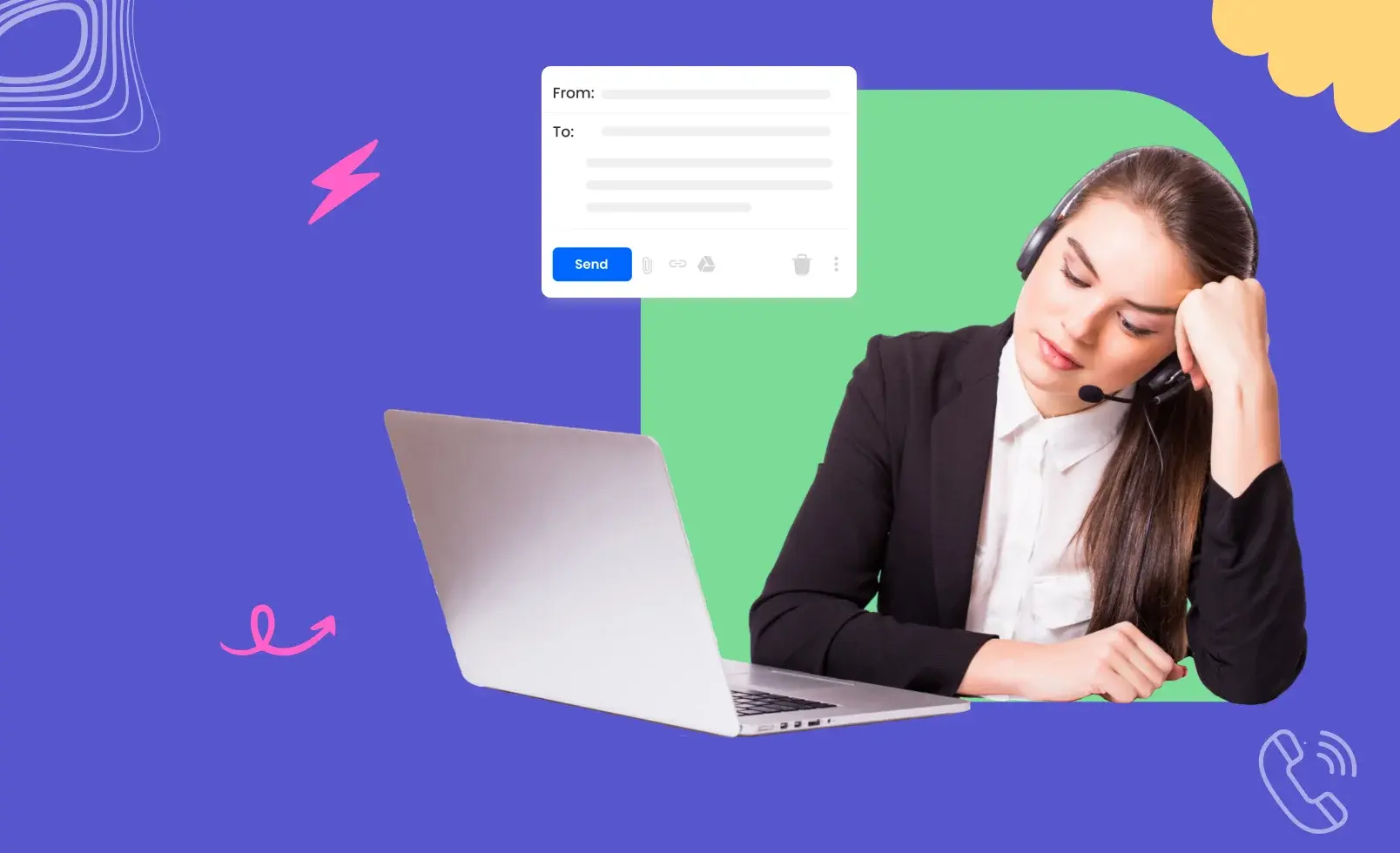When prospects pick up your cold call only to tell you to send them the information over an email - what do you do?
Nod in agreement and get ready to send the email expecting a reply.
When you first hear “Send me an email,” it may not seem like an objection. But it’s one of the most deceptive objections out there. Many prospects can go cold once you've sent the email.
If you are unable to turn this around, then you will be missing out on a lot of opportunities and you will be burning your prospect lists.
SDRs must be well-prepared to handle this to keep the conversation going and get the meeting booked.
In this blog, we will cover 6 ways to handle this objection. But before that, let’s quickly cover why prospects have this objection.
Reasons Why Prospects Say “Send Me an Email”
When sales reps hear prospects say, “Just send me an email,” the first thing on their mind is to send them the email as soon as possible. But what they fail to grasp is that this isn't like any other cold calling objections that prospect use, which usually has a direct meaning. "Send me an email" can have different meanings, like:
a) They are trying to get off the phone. Your prospects are not interested in speaking with you, so they deploy this as an exit strategy to politely brush you off.
b) They are busy with some other work. They are in the middle of something and can’t talk, or they may be going into a meeting and are really short on time.
c) They prefer to read than to hear. 8 out of 10 buyers prefer to be contacted by email. So, maybe your prospect is one of those people who prefer to read the information at a time suitable to make the decision.
As an SDR, your job is to figure out what the prospect intends to mean and handle the objection appropriately.
6 Strategies To Overcome the “Send Me an Email” Cold Calling Objection
Now that you're convinced that "Send me an email" is a cold calling objection that needs to be handled tactfully in the cold call, it's time to answer the question: What do you tell prospects when they ask you to send an email?
To help you out, we've come up with 6 strategies and example cold calling scripts that you can use when prospects pose this objection:
1. Acknowledge and Offer Immediate Value
While respecting the prospect's request, seize the opportunity to provide immediate value that entices further engagement.
Example:"Absolutely, I'll send you a detailed email. However, I'd love to quickly identify which aspect of Revenue ops is most relevant to you. Could you share what's the biggest problem for your team?This works because:
- By acknowledging the prospect's request, you show that you respect their communication preferences.
- Using value-based statements would pique the prospect's interest and encourage them to further engage with you.
2. Clarify the Purpose of the Email
Rather than sending a generic email, take the opportunity to clarify what specific information would be most helpful to the prospect.
Example: "I'd be happy to send you some information. To make sure I include everything you're looking for, could you tell me more about the specific challenges you’re facing in scaling your ABM efforts?”Why does this work?
- Clarifying your email's purpose provides valuable insights into the prospect's pain points, challenges, and priorities. This information can form the base for personalizing future communications.
- Plus, when you take the initiative to learn more about your prospect’s challenges and goals, you're more likely to earn their trust. This opens the door for having good conversations with them in the future.
3. Ask For an Alternative Time To Call
Respect your prospects' time and ask them to schedule a time that would work better for them. This approach will likely advance your efforts more effectively than simply pushing forward.
Example: “I’m sensing this is not a good time for us to speak. Would it be better to call you tomorrow at 7 PM? Will that work?”Here’s how this helps:
- It shows that you respect their time and are willing to accommodate their needs before yours. This creates a positive impression and increases the likelihood of them being receptive to engaging with you at a more convenient time.
- When you propose a time that works better for the prospect, you increase the chances of having a more productive and meaningful conversation.
4. Set a Follow-up Call
A study by Brevet shows 80% of sales require an average of 5 follow-ups to close the deal. But in reality, 44% of sales reps give up after the first attempt.
So, agree with the prospect to send an email and politely ask for a convenient time for a cold call follow-up call to discuss any doubts they have about your product/solution.
Example: "I'll send the email right after our call. What's the best time for a follow-up call to discuss any questions you might have after reviewing the information?"Why does this work?
- You’re being flexible and polite in your ask.
- Your willingness to follow up with prospects to address their doubts shows your commitment and sets you apart from other reps who make no effort to call back.
5. Add Value to Your Email Commitment
Make the prospect look forward to receiving your email. Mention that you will include something of value, such as a case study, a white paper, or an exclusive research report.
Example: “Sure, I will send an email with a case study addressing a similar challenge. It has been incredibly helpful for many of our customers."Here’s how adding value to your email helps:
- Humans are curious beings, so telling your prospects they will receive something valuable creates anticipation and excitement. They are more likely to look forward to it and engage with your email.
- Adding value in the form of case studies, research reports, etc., demonstrates you have valuable insights and knowledge to share, which can help build trust and confidence in your offer.
6. Confirm All the Needed Email Addresses
Ensure you have the correct email address, and ask your prospect if someone else would benefit from the information. This also gives you another opportunity to engage and gather information.
Example: Sure, I’ll send you the email. But can you please confirm your email address and let me know if I have to include anyone else who would benefit from this information?Why is this important?
- Tessian Research found that 40% of employees have emailed the wrong person, and almost 29% of employees said their business lost a client or customer because of the error. So, confirming the correct email address before ending the call ensures that the information you send reaches the intended recipient, avoiding any potential errors.
- Plus, email statistics show reaching out to multiple contacts from the same account gives a 93% increase in response rate.
Use the Right Strategy at Right Time
So far, we’ve discovered different meanings of prospects saying, “Just send me an email,” and strategies to overcome the objection to keeping the conversation going.
But how do you precisely gauge the underlying emotions when prospects say this?
A strong sense of paralanguage—a form of non-verbal communication that includes observing the speaker’s tone and inflection will help you gauge the prospect’s mood during calls.
Aamir Sohail, a top-performing SDR at Vervotech—whom we interviewed during our SDR X Factor Series— judges whether the prospect is interested or not by listening to how their “Hello?” sounds and adjusts his pitch accordingly.
He keeps it brief if it’s an aggressive “hello?”. He offers a concise pitch for hurried prospects, and for those who sound gentle, he engages further to uncover pain points.
Similarly, try to gauge the underlying emotion, and based on this, deploy these six strategies to overcome the objection and navigate the conversation.
For example, when prospects are in a hurry, acknowledge their time and offer value. If they are busy, ask for an alternative time to call. This will help you lay the groundwork for continued dialogue between you and your prospect to make a real connection.

